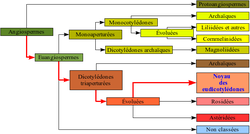- Phytolaccaceae
-
 Phytolaccaceae
Phytolaccaceae
Trichostigma peruvianum Classification de Cronquist Règne Plantae Sous-règne Tracheobionta Division Magnoliophyta Classe Magnoliopsida Sous-classe Caryophyllidae Ordre Caryophyllales Famille Phytolaccaceae
R.Br. (1818)Classification APG III 
Clade Angiospermes Clade Dicotylédones vraies Clade Noyau des Dicotylédones vraies Ordre Caryophyllales Famille Phytolaccaceae 
D'autres documents multimédia
sont disponibles sur CommonsLes Phytolaccaceae (Phytolaccacées) sont une famille de plantes dicotylédones qui comprend une centaine d'espèces réparties en 8 à 14 genres. Ce sont essentiellement des plantes herbacées ou des arbustes, des arbres, des lianes, annuels ou pérennes, principalement des régions subtropicales à tropicales.
La classification phylogénétique en sépare les familles des Achatocarpaceae et des Stegnospermataceae, en revanche le genre Agdestis précédemment classé dans les Agdesticaceae y a été incorporé.
Sommaire
Liste des genres
- genre Ercilla
- genre Gallesia
- genre Hilleria
- genre Microtea
- genre Phytolacca
- Rivineae
- genre Rivina
- genre Seguieria
- genre Trichostigma
Selon DELTA Angio (4 mai 2010)[2] :- genre Anisomeria
- genre Ercilla
- genre Gallesia
- genre Hilleria
- genre Ledenbergia
- genre Lophiocarpus
- genre Microtea
- genre Monococcus
- genre Petiveria
- genre Phytolacca
- genre Rivina
- genre Schindleria
- genre Seguieria
- genre Trichostigma
- genre Agdestis Moc. & Sessé ex DC.
- genre Gisekia L.
- genre Petiveria L.
- genre Phytolacca L.
- genre Rivina L.
- genre Stegnosperma Benth.
- genre Stenosperma (Linnaeus) H. Walter
- genre Trichostigma A. Rich.
Liste des genres et espèces
- genre Ercilla
- Ercilla volubilis
- genre Gallesia
- Gallesia integrifolia
- genre Hilleria
- Hilleria latifolia
- genre Microtea
- Microtea debilis
- Microtea scabrida
- genre Phytolacca
- Phytolacca acinosa
- Phytolacca americana
- Phytolacca dioica
- Phytolacca heterotepala
- Phytolacca insularis
- Phytolacca octandra
- Rivineae
- genre Rivina
- Rivina humilis
- genre Rivina
- genre Seguieria
- Seguieria aculeata
- Seguieria langsdorfii
- genre Trichostigma
- Trichostigma octandrum
- Trichostigma peruvianum
Notes et références
Liens externes
- Référence Belles fleurs de France : Phytolaccaceae (fr)
- Référence Flora of North America : Phytolaccaceae (en)
- Référence Flora of China : Phytolaccaceae (en)
- Référence Madagascar Catalogue : Phytolaccaceae (en)
- Référence Angiosperm Phylogeny Website : Phytolaccaceae () (en)
- Référence DELTA Angio : Phytolaccaceae R. Br. (en)
- Voir aussi Achatocarpaceae.
- Référence Tree of Life Web Project : Phytolaccaceae (en)
- Référence Catalogue of Life : Phytolaccaceae (en)
- Référence Tela Botanica (France métro) : Phytolaccaceae (fr)
- Référence Tela Botanica (La Réunion): Phytolaccaceae (fr)
- Référence The Paleobiology database : Phytolaccaceae Brown (en)
- Référence ITIS : Phytolaccaceae (fr) ( (en))
- Référence NCBI : Phytolaccaceae (en)
- Référence GRIN : famille Phytolaccaceae R. Br. (en)
Wikimedia Foundation. 2010.
